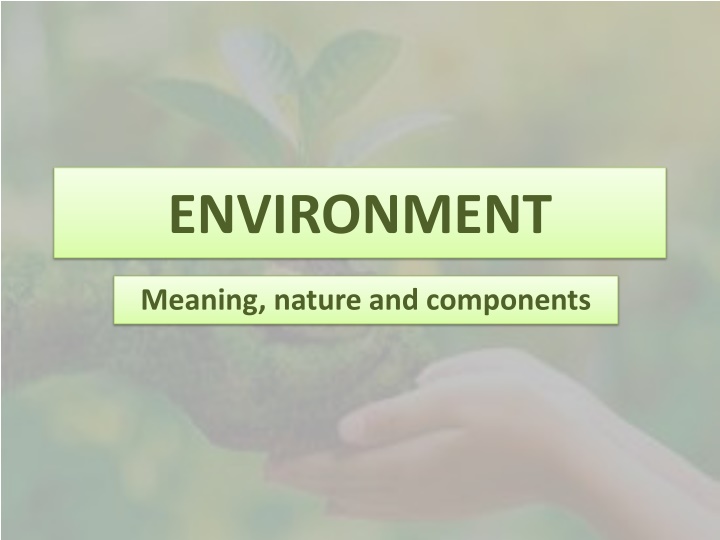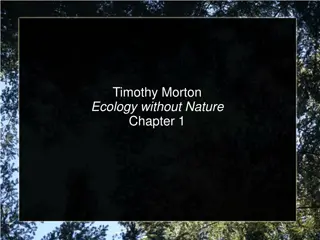Meaning and Nature of Environment
The environment encompasses the conditions where organisms survive, comprising biotic and abiotic elements. It influences life processes and evolution, with physical, chemical, and biological factors shaping its character and impact on all living beings.
Download Presentation

Please find below an Image/Link to download the presentation.
The content on the website is provided AS IS for your information and personal use only. It may not be sold, licensed, or shared on other websites without obtaining consent from the author.If you encounter any issues during the download, it is possible that the publisher has removed the file from their server.
You are allowed to download the files provided on this website for personal or commercial use, subject to the condition that they are used lawfully. All files are the property of their respective owners.
The content on the website is provided AS IS for your information and personal use only. It may not be sold, licensed, or shared on other websites without obtaining consent from the author.
E N D
Presentation Transcript
ENVIRONMENT Meaning, nature and components
Meaning of Environment The term environment has been derived from French word Environia means tosurround . Environment is the sum total of conditions in which an organism has to survive or maintain its life processes. Environment = Habitat = Total set of surroundings In simple words, environment is defined as the natural world in which people, animals and plants live.
Meaning of Environment In other words, environment refers to those surroundings that surrounds living beings from all sides and affect their lives in totality. It refers to both abiotic (physical and non-living) and biotic (living) environment. It lithosphere and biosphere. consists of atmosphere, hydrosphere, It s chief components are soil, water, air, organisms and solar energy.
Definition of Environment A/c to Britannica Encyclopedia, Environment is a complex of physical, chemical and biotic factors that act upon an organism or an ecological community and ultimately determine its form and survival. A/c to P. Gisbert, Environment is anything immediately surrounding an object and exerting a direct influence on it. A/c to E. J. Ross, Environment is an external force which influence us.
Definition of Environment A/c to Douglas and Holland, The term environment is used to describe, in the aggregate, all the external forces, influences and conditions, which affect the life, nature behaviour and the growth, development and maturity of living organisms. A/c to C. C. Park, Environment refers to the sum total of all conditions which surround man at a given point in space and time
Definition of Environment A/c to US Council on Environmental quality, Total environmental system including not only the biosphere, but also his interactions with his natural and man-made surroundings.
Nature and Characteristics of Environment It surrounds the organisms residing on earth. It refers to both the biotic and abiotic components. All interconnected to one another. the components of environment are It acts as an external force which affects us directly or indirectly. It determines the evolution of living forms.
Ecosystem An ecosystem includes all of the living things (plants, animals and microorganisms) in a given area interacting with each other and also with their non-living environment (weather, soil, sun, climate, atmosphere). Ecosystem are the foundations of the biosphere and they determine the health of the entire earth system. Ecosystem: Organisms interacting with each other and the environment.
Ecosystem An ecosystem is an interaction between plants, animals, microorganisms & their environment. All things in an ecosystem, living and non-living, work together to be on functional unit. Definition: Group of living organisms that interact with one another and the non-living physical environment as one unit.
Factors of an ecosystem: 1. Biotic factors Mainly comprises of living components of the ecosystem. e.g., plants, animals etc. 2. Abiotic factors It comprises of non-living components of the ecosystem. e.g., air, soil, water, land etc.
An ecosystem consists of a community of organisms together with their physical environment. Ecosystem can be of different sizes and can be marine, aquatic or terrestrial. Broad categories of ecosystems are called biomes. Biomes contains many ecosystems. Biomes a large naturally occurring community of flora and fauna occupying a major habitat. E.g., forest or tundra.
Types of Ecosystem Terrestrial Ecosystem Forest Ecosystem Grassland Ecosystem Desert Ecosystem Tundra Ecosystem Freshwater Ecosystem Marine Ecosystem
In ecosystems, both matter and energy are conserved. Energy flows through the system - usually from light to heat while matter is recycled.
Atmosphere The thick gaseous layer surrounding the earth. It spreads up to 300 km. above the earth s surface. Apart from gases there are water vapour, industrial gases, dust and smoke particles in suspended state, microorganism etc. Composition of atmosphere (components): Nitrogen about 78% Oxygen 21% Argon 0.93% Carbon dioxide 0.03% The composition of the atmosphere is not static and it changes according to the time and place.
Troposphere It is the lowermost layer of the atmosphere. The height of this layer is about 18 km on the equator and 8 km on the poles. The thickness of the troposphere is greatest at the equator. Troposphere contains dust particles and water vapour. This is the most important layer of the atmosphere because all kinds of weather changes take place only in this layer. The air never remains static in this layer. Therefore this layer is called changingsphere or troposphere.
Troposphere The environmental temperature decreases with increasing height of the atmosphere. It decreases at the rate of 1 degree Celsius for every 165 m of height. This is called Normal Lapse Rate. The zone separating stratosphere is known as tropopause. The air temperature at the tropopause is about 80 degree Celsius over the equator and about 45 degree Celsius over the poles. The temperature here is nearly constant, and hence, it is called tropopause. troposphere from the
Stratosphere Stratosphere is found just above the troposphere. It extends up to a height of 50 km. The temperature remains almost the same in the lower part of this layer up to the height of 20 km. After this, the temperature increases slowly with the increase in the height. The temperature increases due to the presence of ozone gas in the upper part of this layer. Weather related incidents do not take place in this layer. The air blows horizontally here. Therefore this layer is considered ideal for flying of aircraft.
Stratosphere The upper limit of the stratosphere is known as stratopause. One important feature of stratosphere is that it contains a layer of ozone gas. The relative thickness of the ozone layer is measured in Dobson Units. It is mainly found in the lower portion of the stratosphere, from approximately 20 to 30 km above the earth s surface. It contains a high concentration of ozone (O3) in relation to other parts of the atmosphere. It is the region of the stratosphere that absorbs most of the sun s ultra-violet radiations.
Mesosphere It is the third layer of the atmosphere spreading over the stratosphere. It extends up to a height of 80 km. In this layer, the temperature starts decreasing with increasing altitude and reaches up to 100 degree Celsius at the height of 80 km. Meteors or falling stars occur in this layer. The upper limit of the mesosphere is known as mesopause.
Thermosphere This layer is located between 80 and 400 km above the mesopause. It contains electrically charged particles known as ions, and hence, it is known as the ionosphere. Radiowaves transmitted from the earth are reflected back to the earth by this layer and due to this, radio broadcasting has become possible. The temperature here starts increasing with heights.
Exosphere The exosphere is the uppermost layer of the atmosphere. Gases are very sparse in this sphere due to the lack of gravitational force. Therefore, the density of air is very less here.
Hydrosphere The hydrosphere is the combined mass of water found on, under, and above the surface of the earth. This includes water in gaseous, liquid and frozen forms. Components of Hydrosphere Oceans: Most of the water on our planet is salt water, and majority of this saltwater is present in the oceans. Freshwater: Freshwater is much less abundant than saltwater, and is present in a variety of different places. Surface water: Surface sources of freshwater consist of lakes, rivers, and streams. Groundwater: Freshwater stored beneath ground makes up a small portion of the fresh water on Earth. Glacial water: Water that melts off of glaciers.
Hydrosphere Ocean 97.5% Fresh water 2.5% 68.9% - ice 30.8% - fresh groundwater only 0.3% - easily accessible (lakes, reservoirs and river systems).
Lithosphere Lithosphere refers to the rigid and outermost shell on Earth. The composition of it is the crust and the portion of the upper mantle. The crust which forms part of the lithosphere contains around 80 chemical elements.
Biosphere The biosphere is the layer of the planet earth where life exists. In 1875, the Austrian geologist Eduard Suess was first to use the term biosphere to describe the part of the earth where life exists. Later on in the 1920s, Vladimir Vernadsky described the concept of biosphere. Biosphere is also known as ecosphere. Biosphere is the fourth sphere and consists of the places where life can be found.
Biosphere It is the capsule encircling the earth s surface wherein all the living things exists. This portion extends 10000 meters below sea level & 6000 meters above sea level. - - - - - - - - - - - - - - - - - - - - - - - - - - - 6000m Life exists Sea Level - - - - - - - - - - - - - - - - - - - - - - - - - - - - 10000m
Biosphere Life forms do not exist outside this zone. It covers atmosphere, lithosphere. Since life exists in the air, on and in the water and on and in the earth, the biosphere overlaps, connects and influences all the spheres. hydrosphere and























